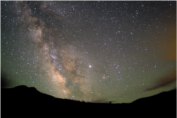Galaxies -
From The Milky Way and Beyond
www.galaxis.comOther Matter in a Galaxy
Gas and Dust

The earth's view of the Milky
Way. Through special tele-
scopes, scientists can see
gases and dust in this band
of light.
The gas and dust throughout in a galaxy is called an interstellar medium (ISM)...what you might call the 'space' between stars in a galaxy. That space has anywhere from a few hundred to a few thousand particles in a square meter.
Only about 1% of the ISM is dust...the rest being mostly a mixture of hydrogen and helium gases. The space between the galaxies is called 'intergallactic space' and is thought to be void of any matter at all—a total vacuum.
Dark Matter
Dark matter is not so much a word to identify what we know, but a word we've come up with to describe what we don't know. It's a hypothetical substance. We know that something is there, but we can't see it, and it gives off no electromagnetic radiation (the way other matter in space does). The only evidence we have of its existence is the fact that it has a gravitational pull.
As an analogy, think about looking out a window and seeing the leaves on a tree flowing back and forth. You can't see the wind blowing. You can't feel it. But you know that it's there because of the way it's moving the leaves. It's the same thing with dark matter.
We know something is there, having an effect on the surrounding matter and energy. But we don't know much about it. We simply know that we have to consider it, because it has an effect on a galaxy...and we can't make predictions about the galaxy unless we take all things into consideration.
The important thing to remember is that it is a hypothetical form of matter. We're guessing...shooting in the dark, you might say. At this point in time, it is a phenomenon more than an actual thing.








